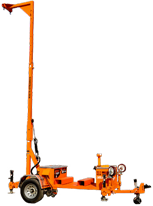The Occupational Health & Safety Administration (OSHA) does not have any requirements for hanging Christmas lights. The key word in this is “occupational” so, nobody is going to give you a fine for putting Christmas lights up without a full body harness on. However, it doesn’t remove the hazard.
During a two year period the Center for Disease Control (CDC) reported over 17,000 injuries in the United States involving the hanging of Christmas lights. Of those 17,000 injuries, nearly 7,500 were injuries from a ladder and an additional 2,300 injuries occurred from a roof. Approximately 62% were 20-49 years old and males were 40% more likely than females to be injured.
There are certainly a lot of things to think about when you hang Christmas lights on a high roof. Typically, the person hanging lights is going to be on a ladder, so following proper ladder safety is key. Some things to keep in mind are; make sure the ladder is extended 3 feet over the edge of the roof and have 3 points of contact on the ladder at all times.
Portable Ladder Safety
At the time this article was written, the Occupational Health & Safety Administration (OSHA) provides the following Quick Card on Portable Ladder Safety.
■ Falls from portable ladders are one of the leading causes of occupational fatalities and injuries.
■ Read and follow all labels/markings on the ladder.
■ Avoid electrical hazards!
○ Look for overhead power lines before handling a ladder.
○ Avoid using a metal ladder near power lines or exposed energized electrical equipment.
■ Always inspect the ladder prior to using it.
■ Always maintain a 3-point (two hands and a foot, or two feet and a hand) contact on the ladder when climbing.
○ Keep your body near the middle of the step and always face the ladder while climbing.
■ Only use ladders and appropriate accessories (ladder levelers, jacks or hooks) for their designed purposes.
■ Ladders must be free of any slippery material on the rungs, steps or feet.
■ Do not use a self-supporting ladder as a single ladder or in a partially closed position.
■ Do not use the top step/rung of a ladder as a step/rung unless it was designed for that purpose.
■ Use a ladder only on a stable and level surface.
■ Do not place a ladder on boxes, barrels or other unstable bases to obtain additional height.
■ Do not move or shift a ladder while a person or equipment is on the ladder.
■ An extension or straight ladder used to access an elevated surface must extend at least 3 feet above the point of support.
■ The proper angle for setting up a ladder is to place its base a quarter of the working length of the ladder from the wall or other vertical surface.
■ A ladder placed in any location where it can be displaced by other work activities must be secured to prevent displacement.
■ Be sure that all locks on an extension ladder are properly engaged.
■ Do not exceed the maximum load rating of a ladder.
○ Be aware of the ladder’s load rating and of the weight it is supporting, including the weight of any tools or equipment.
The question of hanging Christmas lights safely is a bit different, however poses the same risks as a job site. Most of the time though an individual hanging Christmas lights is untrained on ladder and roof safety. For example, the individual is most likely on the roof once or twice a year.
No matter how many times a person is on a roof there are several hazards. Weather conditions and the person’s attire play a big part in safety. Also, the pitch of the roof and location of the structure matter.
An alternative to hanging Christmas lights from the roof would be to decorate from the ground level. This would eliminate the majority of the risks that this activity poses. Also, hiring a trained professional to hang and tear down lights for you is another safe option since they will have the right equipment, can hang them safely and will be properly tied off.
This is a good reminder that at home as well as in the workplace one should always work to eliminate hazards. Eliminating any fall hazard is preferred. One should find ways to complete tasks without working at heights.
Passive Versus Active Fall Protection Restraints
If one cannot eliminate the fall hazard, there are two forms of fall protection restraint; passive and active.
Passive is where a worker does not use a personal fall arrest system (PFAS). Some forms of passive fall protection are guardrails or barricades placed near an edge. Relating this to outside holiday decorations would be decorating elevated windows from inside the home.
Active Fall Restraint involves the worker wearing a full body harness and complete personal fall arrest system. In the case of holiday decorations a good solution would be to utilize a roofer’s bucket kit. The roofer’s bucket kit includes a reusable roof anchor suitable for most residential applications as well as a vertical lifeline assembly to use as a positioning device and a full body harness.
Getting Started With A Personal Fall Arrest System
As a last resort, one would work in fall arrest, meaning that a fall to a lower level could occur but the user has a personal fall arrest system rated and tested for arresting a fall.

